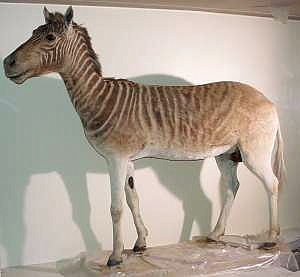There are
23 preserved skins, 7 complete skeletons and few skulls of the Quagga left on this world. It is not
surprising that some of the skeletons belong to the same individual of some
skins, perhaps even all. Most stuffed Quaggas can be found in Germany, others
in the Netherlands, France, Great Britain, South Africa, USA, Sweden and
Russia. Looking at all the different Quagga specimen, which include complete
adult individuals as much as foals and only a part of a leg, gives you a fairly
good idea of the degree of variation within the Quagga subspecies.
Skins
Amsterdam
 |
| The skin of the last living Quagga, well-preserved colour (Photo: ©Artis Museum) |
Bamberg
Basel
Berlin
Cape Town
Darmstadt
Edinburgh
Exeter
Frankfurt
Kazan
Leiden
London
Lyon
Mainz
Milan
Munich
New Haven
No photo found. Probably not on display.
Paris
Philadelphia
No photo found.
Pretoria
No photo found.
Stockholm
Stuttgart
No photo found.
Tring
Tübingen
No photo found.
Turin
Vienna
Wiesbaden
Skeletons
The only skeleton
on display that I am aware of is that of the Grant Museum:
You might
be wondering what happened to the Quagga mare that was photographed in 1870 and
died in 1872 and if she is among the stuffed skins or skeletons that are
preserved till today. The stripe patterns of the two specimens in London do not
fit the animal, nor does any other specimen. Therefore she’s probably not among
the skins. It would be helpful to have more accessible information on the
skeletons. UPDATE: I was addressed that the London mare probably is the specimen now held at the museum of Edinburgh, since the stripe pattern do line up. For a better photo of this specimen, go here.
For more information on the Quagga skins you can have a look at this very useful list on the Quagga Project's homepage.
Call me crazy, but the stuffed skins give me hope that the real Quagga might return some day. A 2009 paper [1] reports that mitochondrial DNA has been successfully extracted from stuffed specimens of the Thylacine, Thylacinus cynocephalus, so there is the reasonable chance that some of all those Quagga skins still preserve certain amounts of DNA. Theoretically, those almost thirty individuals might be enough to recover a healthy population, but I think it is much too optimistic to expect that all of them contain enough genetic material to be cloned. It probably would be a challenge already to gain enough material for at least one individual. However, if one - or even two or three - Quaggas could be cloned one day, it would be a huge sensation. Those Quaggas could be constantly bred into the Rau zebra population which would provide a genetic base for a new near-Quagga population.
[1] Miller, Drautz, Janecka et al. The mitochondrial genome sequence of the Tasmanian Tiger (Thylacinus cynocephalus). 2009.

























I'm quite late to this blog post, however, I wanted to comment on the photographed London mare. Perhaps you have since discovered this, but I believe the London mare is the Edinburgh skin. If one looks at other photos for stripe comparison they actually match. The slight differences being that the skin seems to be stretched over the mount differently than it was on the living animal. Thus, making it appear at first glance that they don't match.
ReplyDeleteThat's pretty cool, you are probably right, thanks very much! The description on this photo seems to confirm it:
Deletehttps://www.flickr.com/photos/peteredin/6175633167/in/photostream/